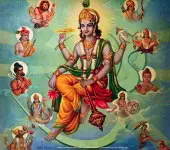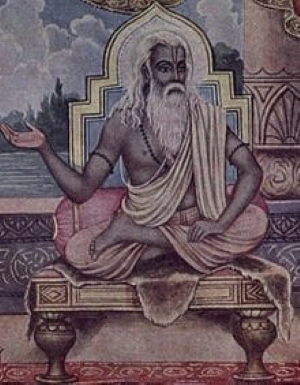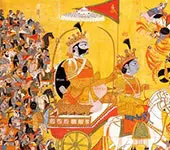This discourse which is part of Mahabharata series tells you about- 1.How long is Mahabharata. 2. Content of Mahabharata 3. Comparison of the characters of Duryodhana and Yudhishtira.
Comments
What is the concept of ahimsa?
Staying away from himsa is called ahimsa. To hurt someone or some being through deeds, words, or even thinking about hurting is himsa. Himsa is done due to greed, rage, or a false presumption that you are doing the right thing. Himsa is perpetrated by oneself or through someone else. Closing your eyes towards himsa when you have the power to interfere is also himsa. The gravity of himsa can be mild, medium, or intense. Staying away from all these twenty-seven types of himsa is ahimsa.
What is the message of Astika Parva of Mahabharata?
A Brahmin should be friendly towards all living beings. He should be the protector of all living beings. Only a Kshatriya or the ruler has the authority to punish. Astika performed his duty as a Brahmin by stopping the massacre of serpents in Janamejaya's Sarpa yajna.
How many slokas are there in the longest version of the Mahabharata?
The longest version of Mahabharata has got 60 lacs of slokas in it. Out of these 30 lacs have been released only in Swargaloka, 15 lacs in Pituloka, and 14 lacs in Gandharvaloka. Only a lac of slokas has been released on earth. (Adi Parva.1.105-107)
Quiz
The slogan Ahimsa paramo dharma is part of which scripture ?Transcript
(Click here to read more)
What is there in Mahabharata? Mahabharata is not just about the fight between Pandavas and Kauravas. Details about Kuruvamsha. How pious a lady was Gandhari. Wisdom of Vidura. Courage of Kunti Devi. Greatness of Lord Krishna. Honesty and truthfulness of Pandavas. Evil ways of Duryodhana. Stories of noble people who have done good karma, hundreds of them. The complete Mahabharata has got sixty lakh shlokas in it. Out of these 30 la....
Transcript
(Click here)
What is there in Mahabharata?
Mahabharata is not just about the fight between Pandavas and Kauravas.
Details about Kuruvamsha.
How pious a lady was Gandhari.
Wisdom of Vidura.
Courage of Kunti Devi.
Greatness of Lord Krishna.
Honesty and truthfulness of Pandavas.
Evil ways of Duryodhana.
Stories of noble people who have done good karma, hundreds of them.
The complete Mahabharata has got sixty lakh shlokas in it.
Out of these 30 lakh shlokas have been released only in Devaloka, 15 lakh shlokas have been released only in Pitruloka.
14 lakh shlokas have been released only in Gandharva Loka.
So, 30 + 15 + 14 – 59 lakh shlokas of Mahabharata are not even known to us, humans.
Only one lakh are meant for humans.
Out of 60 lakhs, only one lakh are meant for humans.
Imagine the vastness of Mahabharata.
Mahabharata was told to Devas by Narada Maharshi.
To pitrus by Asita Devala.
To Gandharvas, Yakshas, and Rakshas by Shukadeva himself.
We heard Mahabharata through Vaisampayana.
Duryodhana and Yudhishthira have been compared to trees.
Duryodhana is a tree of hate and anger.
Its trunk is Karna.
Its branches are Shakuni.
Its fruits and flowers are Dusshasana.
Its roots are Dhritarashtra.
Where does a tree get its nutrients from?
From the roots.
Here Duryodhana as a tree derived its nutrients from its roots, Dhritarashtra.
What was the fault in Dhritarashtra?
Over-attachment to his sons.
That made him blind.
Blind towards dharma.
All his decisions were based on his possessive attachment to his own children.
All decisions and actions of Dhritarashtra centered around the agenda that his own children should benefit.
In this, he overlooked his duty as a king.
A king is there for the nation.
Not for the benefit of his own family.
This principle he violated.
And with the support that Dhritarashtra gave him, Duryodhana flourished as an embodiment of jealousy, hate, and anger.
If Dhritarashtra had brought him up well, kept him under control, exercised his responsibilities as a father, this would not have happened.
Karna, Shakuni, and Dusshasana were parts of the tree that was Duryodhana each contributing in his own way.
On the contrary, Yudhishthira is a tree of righteousness, dharma.
The trunk of this tree is Arjuna.
Its branches are Bhimasena.
Nakula and Sahadeva are its flowers and fruits.
Its roots are Lord Krishna, Vedas, and noble scholars.
Yudhishthira has tolerance in him, he has self-control in him, he has self-restraint in him, he has truth in him, he has ahimsa in him.
But, did he not fight a war?
If he has ahimsa, then why did he go to war?
For this, you should know what is ahimsa.
Ahimsa is the absence of para peeda, tendency to trouble others, harm others.
War was his duty as a Kshatriya.
War was for re-establishment of dharma.
Not to create adharma.
Duryodhana’s actions were adharmik.
Yudhishthira even when he fought a war, it was his duty as a Kshatriya.
What Duryodhana did was unbecoming of a Kshatriya King.
When Yudhishthira fought war there was no himsa in it because it was not meant to harm others, it was not meant for para peeda.
Ahimsa does not mean meekness, submissiveness, timidness.
You follow ahimsa does not mean that anyone can push you around whichever way they want.
Ahimsa essentially means that you don’t initiate harm to others.
Retaliation to adharmik violent acts in equal terms cannot be called himsa.
Arjuna, Bhima, Nakula and Sahadeva; they are parts of the tree that Yudhishthira is.
They are not different from him.
Their actions are always in sync with Yudhishtira’s wish and actions.
And the roots of this tree are Lord Krishna, Vedas, and noble scholars.
Pandavas acted upon the advice of Lord Krishna.
He was their guide.
Nothing can go wrong when you have Paramatma as your guide because he will ensure that divine will is executed, divine wish is executed.
When divine will is executed that means it can not deviate from dharma or the divine order.
Vedas, Shabda Brahma is where you can understand what dharma or righteousness is.
Whatever has the authority of Vedas is dharma.
Whatever Veda says is wrong is wrong.
And the noble scholars are living examples of dharmik conduct.
I am not referring to daily rituals.
How they face situations.
Even they face tough situations in life, dharma sankata in life.
On such occasions how they conduct themselves, that's why they are living examples of dharma.
Lord Krishna, Vedas, and acts of noble scholars; this is where the tree Yudhishthira derives its nutrients from.
Recommended for you
Confidence Of Vibhishana In Rama Nama

Confidence Of Vibhishana In Rama Nama....
Click here to know more..Durga Saptashati - Shapoddharana and Utkeelana Mantras

ॐ ह्रीं क्लीं श्रीं ग्लां ग्लीं चण्डिके देवि शापानुग्रह�....
Click here to know more..Guru Paduka Stotram

jagajjanistema- layaalayaabhyaamaganya- punyodayabhaavitaabhyaam. trayeeshirojaata- niveditaabhyaam namo namah' shreegurupaadukaabhyam. vipattamah'sto....
Click here to know more..
English Topics
Mahabharatam
Click on any topic to open
- 96 Two Curses That Worked against Karna
- 95 What is behind Calling the Five Brothers the Pandavas
- 94 Give up an Individual IF....
- 93 Fascinating Birth Story of the Kauravas
- 92 Overcoming Grief - Lessons from King Senajit's story
- 91 Yayati's Wisdom
- 90 Yayati's Story
- 89 Brahmacharis Can Bless And Curse
- 88 Human Nature - Comples Mix Of Good And Bad
- 87 Results Of Good Karma
Please wait while the audio list loads..
30
Ganapathy
Shiva
Hanuman
Devi
Vishnu Sahasranama
Mahabharatam
Practical Wisdom
Yoga Vasishta
Vedas
Rituals
Rare Topics
Devi Mahatmyam
Glory of Venkatesha
Shani Mahatmya
Story of Sri Yantra
Rudram Explained
Atharva Sheersha
Sri Suktam
Kathopanishad
Ramayana
Mystique
Mantra Shastra
Bharat Matha
Bhagavatam
Astrology
Temples
Spiritual books
Purana Stories
Festivals
Sages and Saints
